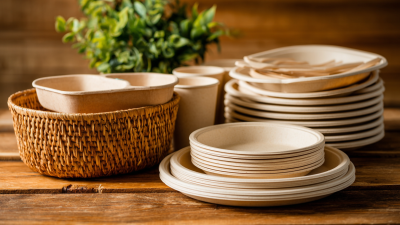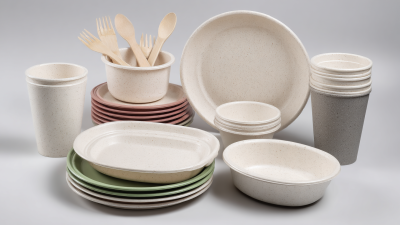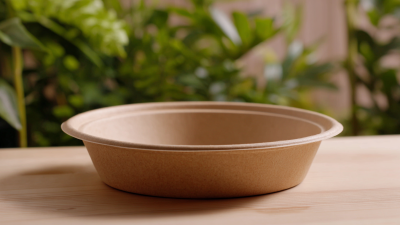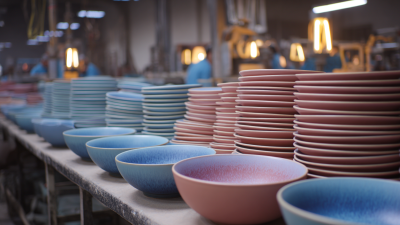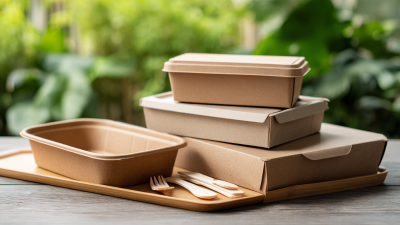As the demand for sustainable solutions continues to grow, events of all sizes are increasingly considering the environmental impact of their choices, particularly when it comes to food service. A significant portion of the global waste generated comes from single-use products, with reports indicating that over 300 million tons of plastic waste is produced annually, and a substantial part of this is contributed by disposable tableware.

Biodegradable disposable plates have emerged as a top alternative, providing an eco-friendly option that can break down naturally, reducing landfill contributions. According to recent studies, the biodegradable tableware market is expected to reach USD 3 billion by 2025, reflecting a shift towards more sustainable practices in event planning. In this blog, we will guide you through the essential factors to consider when choosing the best biodegradable disposable plates for your events, ensuring you make informed decisions that align with both your aesthetic and environmental goals.
When planning your event, selecting the right biodegradable disposable plates is crucial to ensure both convenience and environmental responsibility. One of the primary factors to consider is the material. Many products are made from plant-based materials like sugarcane, bamboo, or palm leaves, which can decompose naturally in composting conditions. A report from the Biodegradable Products Institute indicates that these options often break down within 90 to 180 days, compared to traditional plastics that can take hundreds of years to decompose.
Another important factor is the plate's usability. Ensure that the plates are sturdy enough to hold your food items without bending or leaking. Look for certified products that meet ASTM standards for compostability, which guarantees that they break down effectively in composting environments.
**Tip:** Test the plates with a sample of the food you plan to serve to gauge their durability. Additionally, consider the plate's size and design; larger events may require versatile plate sizes to accommodate various portions, while elegant designs can enhance the presentation. Always check for any certifications on the packaging to confirm their eco-friendliness and ensure you're making an informed choice.
When planning events, the choice of biodegradable disposable plates is crucial for minimizing environmental impact. Let's focus on three prominent materials: paper, CPLA, and palm leaf, comparing their benefits and drawbacks to help you make an informed decision.
Paper plates are widely available and come in various styles, making them versatile for any occasion. They are often made from recycled materials, but it’s essential to check if they are coated with any non-biodegradable substances. CPLA, or modified corn starch, offers a robust and eco-friendly option that can withstand heat better than traditional paper plates. However, they may not be suitable for hot and oily foods, so consider the menu when selecting CPLA.
Palm leaf plates have gained popularity for their natural aesthetic and sturdiness. Made from fallen palm leaves, they are compostable and add an elegant touch to any gathering. Notably, palm fibers have a lower density compared to synthetic materials, making them lightweight yet durable.
Tips: Always opt for certifications that guarantee compostability when choosing biodegradable plates. Additionally, consider the type of food being served to match it with the right material, ensuring both functionality and eco-friendliness. Lastly, think about your event's aesthetics—selecting plates that complement your theme can enhance the overall experience while staying environmentally conscious.
When planning an event, selecting the right biodegradable disposable plates is crucial, especially when considering the size and shape options that best fit the occasion. Different events call for different types of serving ware—whether it's a casual picnic or a sophisticated wedding. For smaller gatherings, smaller plates are appropriate, allowing for a more intimate dining experience. Conversely, larger events may benefit from larger plates that can accommodate diverse dishes, providing your guests with a complete meal presentation.
 For instance, round plates tend to be versatile, suitable for everything from appetizers to main courses, while square plates offer a modern aesthetic that can enhance the overall table setting. Additionally, portion control is essential; selecting plates that align with serving sizes minimizes food waste and reinforces the eco-friendly theme of using biodegradable materials. Understanding the varying shapes and dimensions can significantly impact not just the look but also the practicality of your event's dining experience. Choose wisely to ensure both functionality and style resonate with your event’s atmosphere.
For instance, round plates tend to be versatile, suitable for everything from appetizers to main courses, while square plates offer a modern aesthetic that can enhance the overall table setting. Additionally, portion control is essential; selecting plates that align with serving sizes minimizes food waste and reinforces the eco-friendly theme of using biodegradable materials. Understanding the varying shapes and dimensions can significantly impact not just the look but also the practicality of your event's dining experience. Choose wisely to ensure both functionality and style resonate with your event’s atmosphere.
When selecting biodegradable disposable plates for your events, evaluating their strength and durability is crucial to ensure that they can withstand the demands of your occasion. Biodegradable plates come in various materials, such as sugarcane, palm leaf, and cornstarch. Each material has unique properties that affect its strength and durability. For instance, plates made from sugarcane pulp are typically sturdy and can handle both solid and liquid foods, making them an excellent choice for catering.
To effectively assess the durability of biodegradable plates, consider performing a simple stress test. Fill a plate with typical event foods and observe how well it holds up over time. Look for signs of sagging, leaking, or breaking, which can indicate that the plate may not be suitable for your needs. Additionally, check whether the plates are designed for hot or cold items, as some may not withstand high temperatures or may buckle under the weight of heavier dishes. By emphasizing these factors, you can confidently choose the right biodegradable disposable plates that will maintain their integrity throughout your event.
| Plate Material | Strength Rating | Durability (Hours) | Biodegradation Time (Months) | Heat Resistance (°C) | Eco-Friendliness Rating |
|---|---|---|---|---|---|
| Sugarcane (Bagasse) | 8/10 | 3-4 | 2-3 | 100 | High |
| Palm Leaf | 9/10 | 4-5 | 3-6 | 120 | Very High |
| PLA (Polylactic Acid) | 7/10 | 1-2 | 6-12 | 60 | Moderate |
| Bamboo | 8/10 | 3-4 | 4-6 | 90 | High |
| Recycled Paper | 6/10 | 2-3 | 1-2 | 70 | Moderate |
When planning an event, choosing eco-friendly disposable plates is crucial for minimizing environmental impact. Sourcing products from sustainable brands not only supports eco-conscious companies but also ensures that the materials used are safe for the planet. Look for brands that emphasize biodegradable materials, such as bamboo, palm leaves, or recycled paper. These options decompose naturally, reducing waste and promoting a healthier ecosystem.

One important tip is to read the labels and certifications. Look for products that are certified by organizations like the Biodegradable Products Institute (BPI) or have compostable labels. This guarantees that the plates will break down under the right conditions without leaving harmful residues. Additionally, consider the brand's overall sustainability practices, such as sourcing materials responsibly and using environmentally friendly manufacturing processes.
Another effective approach is to choose local brands. Supporting local businesses not only reduces carbon footprints associated with transportation but also fosters community engagement. Many local suppliers are committed to sustainable practices and can provide personalized service. By prioritizing eco-friendly brands, you ensure that your event reflects a commitment to sustainability while providing guests with high-quality disposable plates.
